Christine Renee – Hesse Wrote the Permission Slip
Interview by Barbie Bertisch | Photos by Eilon Paz
t’s hard to miss Christine Renée when scanning a crowd–she exudes a certain level of effortless cool, maybe a result of having lived many lives. From her electric looks and magnetic energy to her spectacular vibe when in action, she’s become what I’d consider a musical chameleon. We met a few years back, when I was starting my path in the world of DJing and we’ve been in each others’ orbit for some years, having shared the odd intimate moment that being out and about affords you.
This interview was the perfect excuse to ask everything I always wanted to know about her as our paths have grown closer over the past few years. It’s rare to meet someone with a trajectory as unique as hers but her music taste reflects this story: multifaceted, adventurous, forever curious, and fun. Christine Renée (and her record collection) have been all over the country, and it was timely and special to sit down for this interview as she prepared for the move to Brussels.

Where were you born and raised?
Austin, TX
Did you grow up with music around the house?
Simply yes…
My Dad is a musician, and Dad-time always revolved around music history.
He’s a collector, so records were a big part of my life from day one. Certain ones define moments our family has shared. Also what my dad played and when he played it, was interesting. He’d played King Crimson to put me to sleep, and Howlin’ Wolf, Lightnin’ Hopkins style blues on Sunday mornings. We always decorated the Christmas tree to a reggae soundtrack.
We also talked about different sound facets, which I think ultimately led to me having an antenna for sound’s “extra-capacities”. He trained me to hear music’s ephemeral information, its essence. It guided my belief that particular musicians are able to deliver music with a sort of oracular power.
One way he trained my ear was by playing 10 secs of a guitar solo. I was supposed to guess who was playing, not based on how the song was played, but based on what was beyond the song, so to speak.
I learned the difference in tonal qualities via guitars: Telecaster, Strat, Les Paul, etc, and he encouraged me to love tube amps versus solid-state. I’d help him find Marantz receivers at pawn shops.
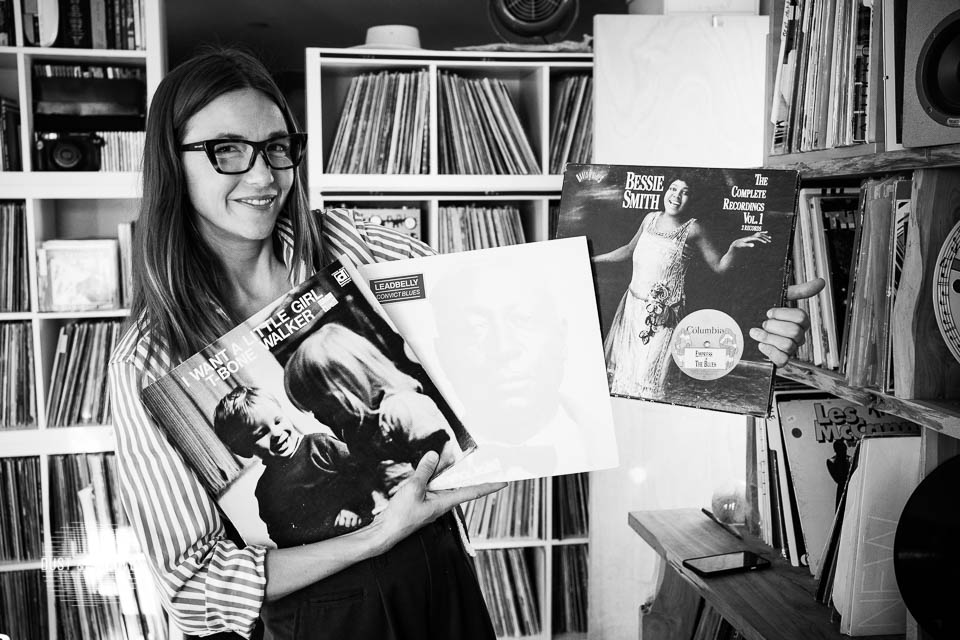 T-Bone Walker, Leadbelly, Bessie Smith. Blues was a big part of my musical education, a great point of departure if you study music of the US… and the world. I like the early stuff and adore the way it developed in T-Bone’s guitar playing.
T-Bone Walker, Leadbelly, Bessie Smith. Blues was a big part of my musical education, a great point of departure if you study music of the US… and the world. I like the early stuff and adore the way it developed in T-Bone’s guitar playing.
Did anyone in your family play any instruments or sang or were they appreciators?
We all play a little. We still like to have family jam nights that are fully mic’d and amped. My mom or brother would play rhythm guitar, my dad the leads and we all sang. Mostly Dylan, Beatles and the Stones.
What is your earliest music memory?
I was surrounded by music from the beginning so it’s hard to say, but maybe it would be this time… My parents and I weren’t in the same state when I was born. A few days later when we were all three united was a moment christened with the Dylan song, “Sad Eyed Lady of the Lowland”. When I hear it I can recreate the tenderness with a very cinematic memory of me in the middle of two adoring parents.
Maybe my earliest music muscle-memory came from participating in “sessions” since I was born. When I was an infant, my mom worked a night shift, and I was mostly with my dad at night. His friends would come over, they’d listen to tunes and talk shop. Later it occurred to me that this could be the reason I was always very comfortable being the only woman in a mostly male environment as a teen or young adult, just hanging with the boys listening to music, always striving to learn and know more.
I felt different from everyone else (like Hesse’s protagonist Harry Haller) and torn by internal forces that seemed at odds with each other. This made Haller incapable of a peaceful individual existence or proper societal integration. I related to that conflict.
Were there record shops where you lived as a kid?
Austin is still rated as one of the top ten vinyl cities in the country. I went to stores with my dad at least once a week, as far back as I can remember until I was able to get to them on my own. Records were literally everywhere in Austin, in stores dedicated to music like Waterloo, Sound Exchange and Tower Records, but also in books stores like Half Price, thrift stores like Goodwill, pawn shops and garage sales. We went to all of them, as well as the bi-annual convention. I learned the physicality of record shopping: how to squat for long periods and time and how to flip through bins quickly at a young age.
What was the music like in your house?
We listened to The Beatles, Led Zeppelin, Hendrix, Stones, and by extension, the blues like T-Bone Walker, James Cotton or Sonny Boy Williamson. There was also the mental, musical language of Crimson, Genesis, Yes or Zappa.
All music was played on vinyl, a Technics SL 1500, Audio Technica AT120E stylus, Marantz 2275 receiver and Bose 901 speakers.
Assuming we are in your early – late teen years here… When and how did you begin searching for music on your own terms?
I had two aunts and an uncle who were just a few years older than me. Thanks to them, I got into 80s pop, new wave and post punk. They fit into different cliques in their schools and as a result were into divergent sounds covering all the bases of the times.
I had the “preppy” Aunt who was on the high school drill team. The athletic uncle and the cool, misunderstood Molly Ringwald character. They each taught me totally different things about music.
When I spent summers with them, the preppy ones loved The Police and we watched a lot of MTV. This was the time when The Cars “It’s Magic”, A-ha’s “Take on Me”, Dire Straits’ “Money for Nothing” and Michael Jackson were on heavy rotation. The “rebel aunt” wore cowboy boots with big 50s circle skirts, a tight t-shirt and leather men’s belts. Her head was half shaved and the rest of her bleached-blonde hair had a life of its own, and flipped from one side to the other when she talked. She was a rockabilly punker in style, and by extension she taught me about The Cramps, The New York Dolls, The Stray Cats, etc.
One day I FOUND a copy of Guns and Roses’ “Appetite for Destruction” on the sidewalk (on the way to elementary school). I was into MTV hair metal: Poison, Whitesnake, but GnR blew my 5th grade mind. Still, everything I discovered seemed more or less derivative of what I’d learned from my dad.
I cut the sonic umbilical cord when I discovered Nirvana on MTV Headbangers Ball. They were doing an in-store at Waterloo records followed by a show at Liberty Lunch. I saw them at the store and got a cassette of Nevermind signed. Hearing “Smells Like Teen Spirit” at the ripe age of 14 was mind bending. It was the first time it occurred to me that something my parents didn’t know about existed beyond the house walls and I was intent on discovering all of it.
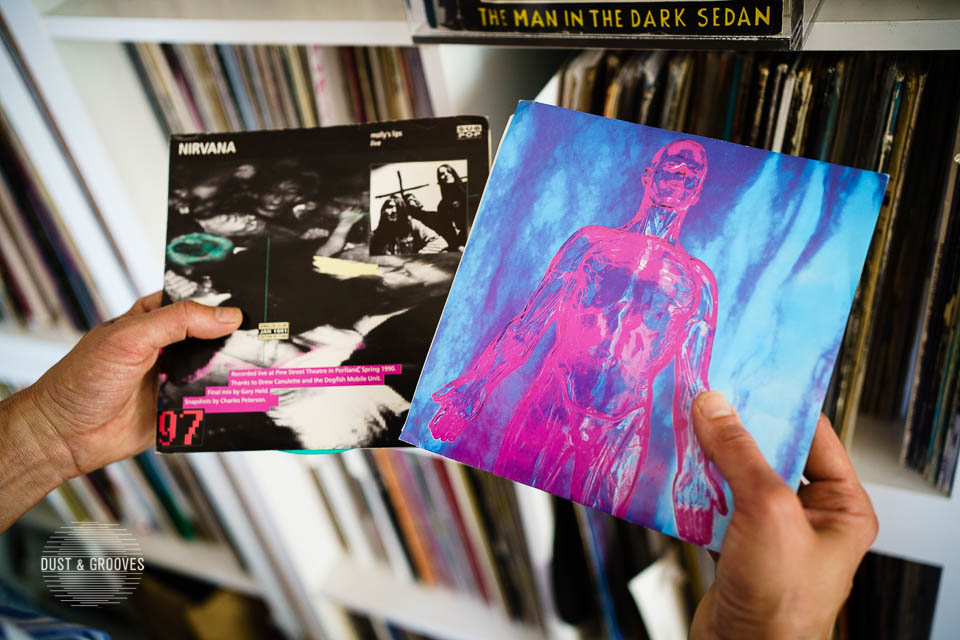 Nirvana – “Silver” b/w “Dive” (1990) and “Molly’s Lips Live” b/w “Candy” (1991). These were released right before Nevermind. I bought them in 1994 from Sound Exchange in Austin after Kurt died.
Nirvana – “Silver” b/w “Dive” (1990) and “Molly’s Lips Live” b/w “Candy” (1991). These were released right before Nevermind. I bought them in 1994 from Sound Exchange in Austin after Kurt died.
 Bailter Space – Tanker. This classic post punk record was with a bunch of other Flying Nun records that I traded my Barbie doll collection for after moving to NYC. In that batch was a release by their first band, The Gordans.
Bailter Space – Tanker. This classic post punk record was with a bunch of other Flying Nun records that I traded my Barbie doll collection for after moving to NYC. In that batch was a release by their first band, The Gordans.
With your parents being so open-minded, did they vibe with Nirvana or did they reject it?
They didn’t become fans, but they supported my interests except when it came to anything my dad considered “whiney”. There was a local musician who I really liked called David Garza, a folk/college rock guy, and my dad hated the music. He’d ask me to turn that down if he could hear it playing in my room. I found that humorous more than anything, because he felt actually aggressed by what he called “sap”.
He was into heavy, complicated and sometimes heavily complicated stuff. When I was a teenager, he got into metal. I would ask him to turn THAT down when he was blasting it, to which he would respond, “Christine, if it’s too loud, you’re too old,” an AC/DC joke we integrated into our family lingo.
What do you think resonated with you?
Maybe like all teenagers, what resonated with me then was all that lay beyond the mainstream. I wanted to expand beyond the obvious. I looked to the obscure because it mirrored my inner emotional life. I needed to connect with what was disturbing, enchanting, feral, raw and honest.
I was reading from the underground cannon at the time (9th grade); On the Road and SteppenWolf had a huge impact.
I felt different from everyone else (like Hesse’s protagonist Harry Haller) and torn by internal forces that seemed at odds with each other. This made Haller incapable of a peaceful individual existence or proper societal integration. I related to that conflict. But then Haller finds salvation in his debauched experience at the dance hall. His inner journey at the Magic Theatre revealed that you can have your cake and eat it too, if you’re able to shed the judgement of others. That ALL is part of the human experience, and there’s no shame in the game. So Hesse wrote the permission slip, Kerouac was my GPS and Nirvana was the soundtrack.
I was pretty sure there were three keys to my success in life: Steadfast learning, surrounding myself with those who were “mad to live,” and personally experiencing everything I could, good or bad, at least once.
The post punk, hardcore and indie rock scenes were the perfect places to explore this. We were challenging all we’d been raised with. Everyone in those scenes knew that Capitalism and its sister, Consumerism, were evils that would be society’s downfall. We believed that our governments were self-serving, and that there was no room for our protesting voices. So, we created subcultures that provided safe zones where we could create and exist according to our rules.
At those shows you could jump in a mosh pit if you were pissed at your parents, and work it out violently, something “normal” people didn’t do. Those on stage and audience members were exploring their inner selves in a performative space, and at times it was pretty dark. It was all pruriently attractive. I guess part of me was an Emo kid but I also didn’t fully connect with that. I felt I didn’t belong 100% to that scene, or any scene thereafter.
There were some pretty f-ed up stage antics at some of the 90s shows involving nudity, indoor fireworks and/or cows’ tongues. It wasn’t until very recently that I realized this was performance art, straight up. Not everyone was piercing their faces with insects or banging the mike on their head till they drew blood, but those that did were part of our Austin music scene as much as the “real musicians”.
The 80s and 90s were a singular time musically/artistically. Punk was the unifying philosophical foundation of everything generated by those indie scenes.
Once you subtract conventions like the belief that a musician must play an instrument, you open up stage space for other types of expression, and people were all over the place. There was a lot of freedom, but that freedom often demanded some form of self-destruction in return. It was dark with little hope that things would ever change on a mass scale.
I accepted these things as part of the music scene, sometimes forcing myself to be comfortable when I wasn’t. This was how I came to photograph the shows. It was a way for me to be present with the protection of being behind the lens. It gave it all a purpose I could justifying attaching myself to.
Did you understand the importance of photographing your scene at the time? Did you keep those photos?
I thought the photos might be interesting, one day, for their nostalgic value. Important, I guess, is to be determined.
I read Susan Sontag’s On Photography and stopped photographing at some point. That book opened me to the realization that the camera was a buffer to reality. When I realized that, I dropped it. I do still have the photos, most of them are in negative form. I haven’t looked at them in decades, but someone is organizing a 90’s punk reunion in Austin this year. I might organize them to share them there.
Were these hardcore spaces welcoming to young women? Did you get into Bikini Kill and the Olympia feminist punk scene?
I would say the hardcore spaces were welcoming, very much so, with the caveat of, they were as welcoming as the social environment could allow for the time.
It was a safe space for gender and sexual preference exploration, because acceptance was a key unifier in that world. But this was a door that was JUST starting to crack open with Bowie to Morrissey to Anthony Kiedis or even J. Mascis. Men in the scene allowed themselves to be vulnerable at times. More and more were beginning to allow themselves to be perceived as female or ambiguous in gender, but the scene was still a lead guitar, frontman driven world.
These spaces were and are always greatly influenced by the technology, political landscape and gender/sex relations dominating the time, and this mix was further influenced by specific geographical locations. What was happening in DC or Olympia was communicated only by the records with national distribution, zines and mostly by a band’s ability to tour.
A band like The Minutemen, for example, saw touring as a civic duty. Their punk war cry of “Go out and make your own band” spread far and wide even across the Atlantic where it was adapted by Andrew Weatherall’s peer “Dickie” Norris in an influential ‘zine called, “Boy’s Own” to the UK Acid House scene as, “Here’s a sampler, here’s a keyboard, here’s a drum machine… now go form your own band.” This is interesting because the technology enabling this DIY credo to spread musically was extremely crude by today’s standards, but somehow the punk message worked its magic and made the rounds.
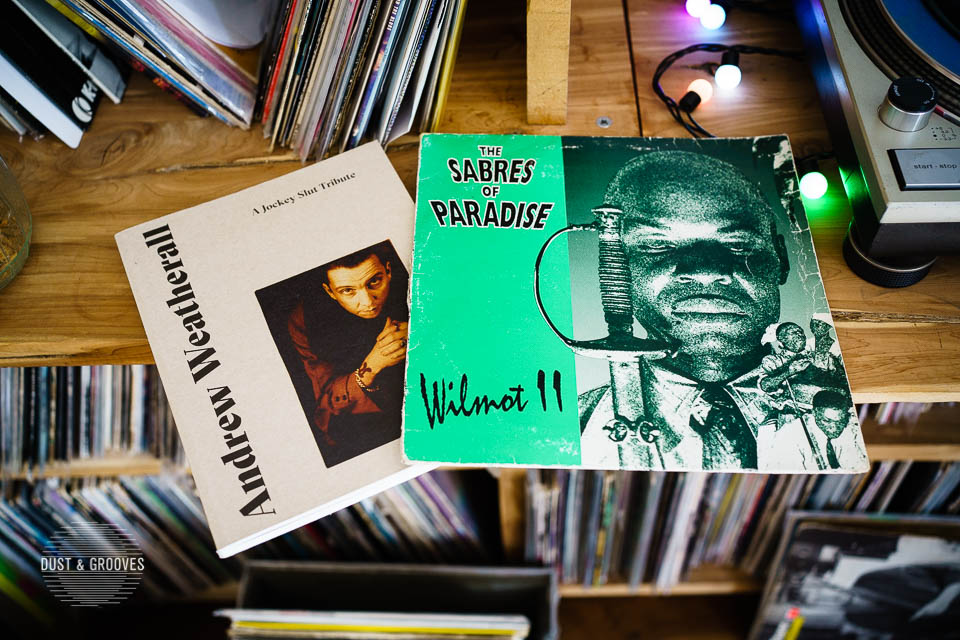 Andrew Weatherall. A book that documents his life (Defected) and a 10” by one of his bands, The Sabres of Paradise. I recently dove into Andrew Weatherall’s work and that accumulated in a Lot Radio show in which I played this song, “Wilmot 11”. I only had a digital copy of it, a conjunto, dub tune, and the next week I found it stuck inside a curio-shelf at an antique store in Greenpoint. The record found me.
Andrew Weatherall. A book that documents his life (Defected) and a 10” by one of his bands, The Sabres of Paradise. I recently dove into Andrew Weatherall’s work and that accumulated in a Lot Radio show in which I played this song, “Wilmot 11”. I only had a digital copy of it, a conjunto, dub tune, and the next week I found it stuck inside a curio-shelf at an antique store in Greenpoint. The record found me.
I liked what Bikini Kill stood for, but it was distant, literally since I was in Texas and those grrrls were in Washington. I still have Pussy Whipped and even listen to “Rebel Girl” fairly frequently, but there was something about the sound of many female driven groups inspired by that scene, that I couldn’t get into musically. It was the drum signature, kind of a cute, polka-like ¾ time on most songs.
Back then, it sounded to me like people who’d just learned how to play. Which is fine and can be GENIUS as in the band Beat Happening, but I also found it a bit boring. To be fair, they probably did just learn how to play versus the dudes in the scene who might have been handed drum sticks when they were five by their fathers. Good on the ladies for doing what they wanted to despite the odds!
And of course, it wasn’t just about the music. The riot grrrls grew out of their scene’s dynamic that desperately needed to be addressed and amplified. But it just wasn’t like that in Austin, for example, I felt fairly safe jumping into a mosh pit there. Bikini Kill members have horrible stories about how the energy of the pit was turned on women resulting in rape in some cases.
Bikini Kill was rocking it though, and I massively respect their work as pioneers of third wave feminism, work that continues today.
My female idols were Aretha Franklin, Patti Smith, the Kims (Deal and Gordon), Poison Ivy, and Keira of Black Flag. I was getting into hip-hop and loved Queen Latifah, Roxanne and even, Salt-n-Pepa, Bananarama, the Go-Go’s, Madonna and Cyndi Lauper… Downtown Julie Brown belongs in that early grouping, as well as Lady Miss Kier. All massive influences.
What about it, if you remember, felt most exciting to you about records?
Finding the links, unraveling the “whys” behind a record. Every record is a story that leads to another. Who was the producer? Who else is on the label? What other bands were the members in? I never get tired of learning this stuff.
How would you go about discovering new things at a record shop? What drew you in first?
My approach was diligence. I went to a school called Bowie High (James not David), but I was taking a two year photography class at Austin High which was near Waterloo records. I had an hour off from the end of that class ended to my next class at Bowie which was only 15 min away.
So I’d squeeze in a visit to the store after class. Once I knew the inventory, I pretty much only hit the new arrival bins on a visit. Actually, I’d alternate going to the record store with going to thrift stores or stopping somewhere to photograph things. Good times.
In what other ways was music making itself known to you? Was it TV? Friends? School?
It was basically, friends, their older siblings, SNL (had great band curation), the radio, and Austin itself. The college and public radio stations played some really rare and obscure underground stuff: old, new and international. And The Chronicle (a local paper) listed all the bands coming through. I used to read all of the listings, and then do my best to figure out who these bands were. Usually that led me to the record store or to the show itself if I liked the other bands on the bill. Once I could drive at 16, I was going out almost 5 nights a week. But my parents were not loose with me. I had to be home by a certain time and keep my grades up, which I did.
Do you remember your first record purchase? Was this back home or after you moved to NY?
The first record I ever asked for, and I asked the Easter bunny for it, was Jackson 5’s Greatest Hits. Then in 3rd grade I “earned” Michal Jackson’s Thriller by selling candy bars or something for the school. Around the same time, you could order Michael Jackson’s narration of the film E.T. on vinyl if you ate enough E.T. cereal, which of course I did and not ‘cause I liked it.
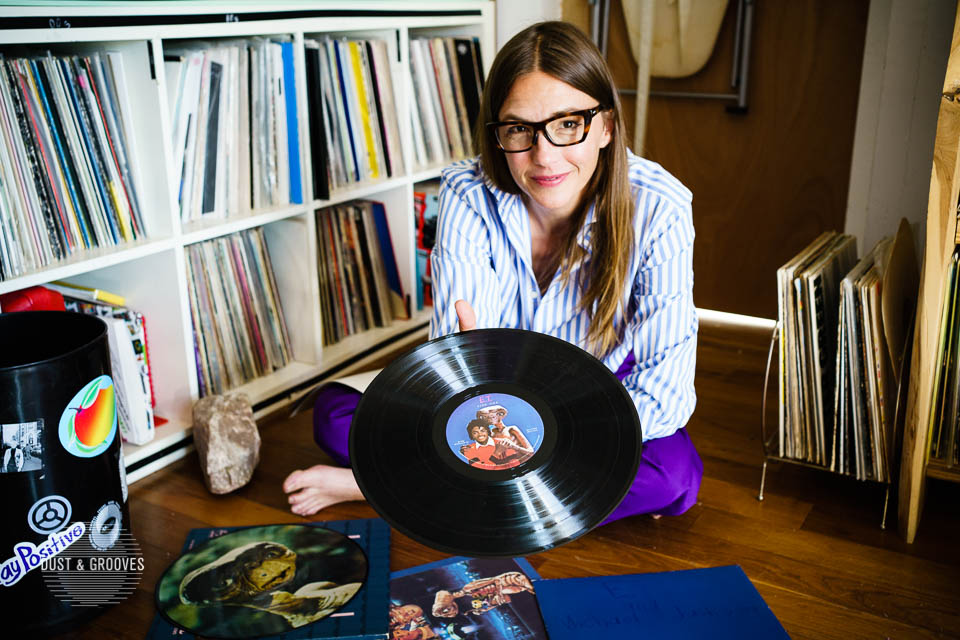 Michael Jackson/John Williams – E.T. The Extra-Terrestrial. The first record I was driven to collect was this record in which Michael Jackson narrates the E.T. story. I had to gather UPC codes from E.T. cereal boxes and snail-mail them in with a check, and then… wait (1982).
Michael Jackson/John Williams – E.T. The Extra-Terrestrial. The first record I was driven to collect was this record in which Michael Jackson narrates the E.T. story. I had to gather UPC codes from E.T. cereal boxes and snail-mail them in with a check, and then… wait (1982). 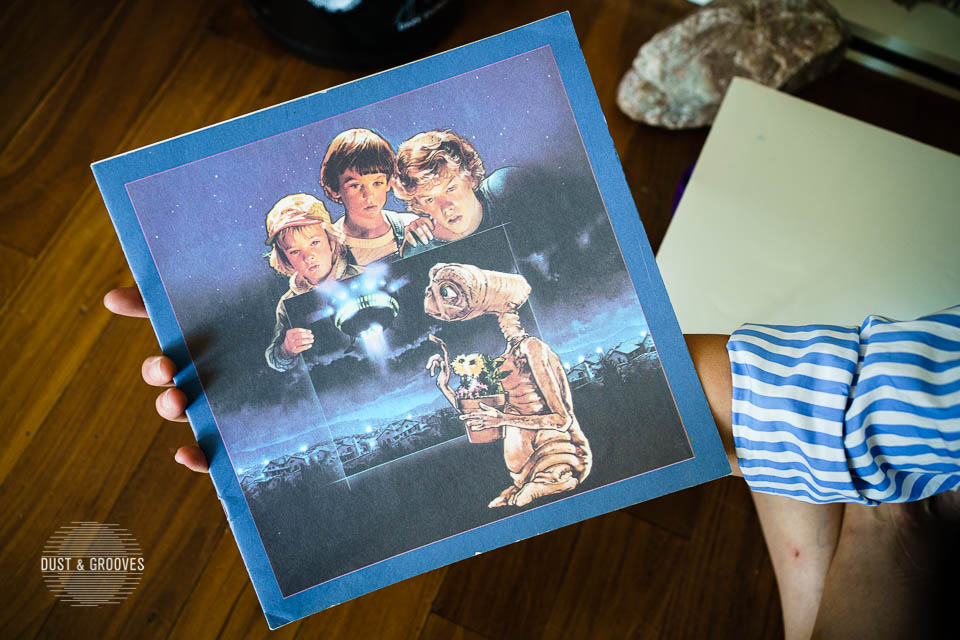 If a person could stomach the metallic aftertaste of conveyor belt, peanut butter flavored E.T. cereal, you could own this masterfully arranged consonance of 80s pop culture icons. It’s expertly produced, but also I love it for being a creepy product of the US consumer machine.
If a person could stomach the metallic aftertaste of conveyor belt, peanut butter flavored E.T. cereal, you could own this masterfully arranged consonance of 80s pop culture icons. It’s expertly produced, but also I love it for being a creepy product of the US consumer machine.
Did you ever collect anything else or were records the only thing you gravitated towards?
I collected coins when I was little. In junior high I started collecting Barbies, not because I was playing with them, but because I was fascinated with what they said about femininity. I was particularly fascinated with the career Barbies, and collected all the military Barbies from the army base which I had access to through my grandparents. I also collected Pez dispensers in high school. In college, I collected bikes! I had 7 at one point and worked in a bike mechanic shop briefly. My thrifting habit is a form of collecting.
I can see your sense of style being such a clear creative expression of who you are. Colorful, multifaceted, artful. Would you agree that your record collection takes a similar approach?
Yes. I think I do approach them both in the same way, back to the method of collecting. My parents NEVER bought me new clothes. They couldn’t afford it. So we thrifted, my mom, aunt and I. Automatically, that removes the cookie cutter look that will happen if you’re only shopping in malls. It allows you to be more expressive, going for what attracts you amid a bunch of junk that doesn’t. For me, the mess and lack of curation are elemental to finally arriving at “the real deal” in the form of a vintage jacket or what have you.
It’s the same with digging for records. Even the physical action of flipping through hangers is similar to flipping through records. Mixed in with all those things that don’t make sense for you, something will emerge that does. And you look for clues in both cases which you get better at deciphering with practice and experience. What’s the clothing’s material content, brand, etc. After a while you’ll know most of that info in seconds by touching the garment as you flip. It’s very similar to how I collect records.
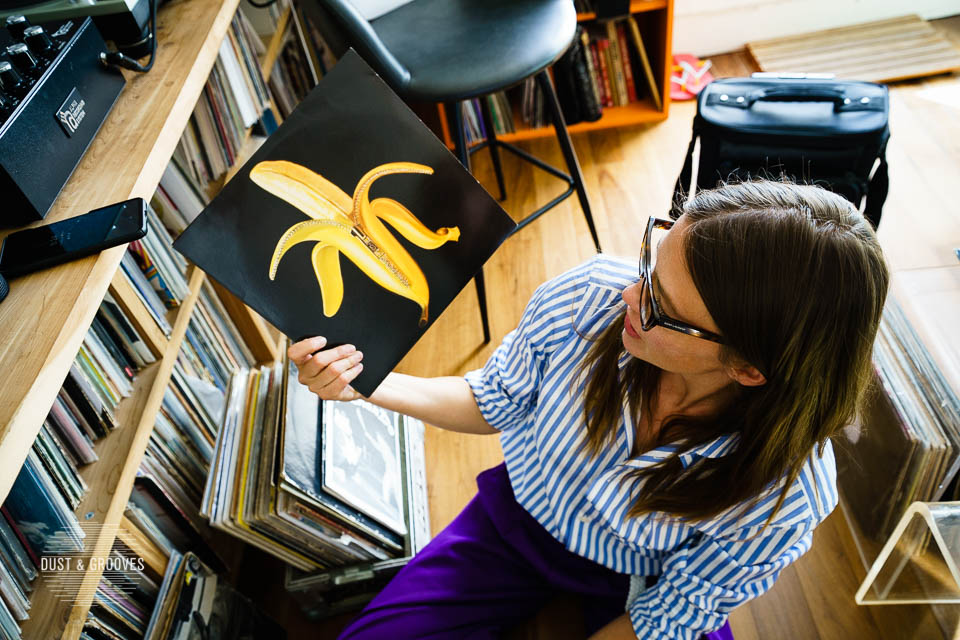 The Dandy Warhols – Welcome to the Monkey House. I met these guys through my partner J. Space and they hired me to shoot them for this release during its recording at Electric LadyLand studios. I was thrilled to have VIP access to such a historic place and I got to “live” in Dig! a documentary released years after, that chronicles the Dandys’ relationship with The Brian Jonestown Massacre.
The Dandy Warhols – Welcome to the Monkey House. I met these guys through my partner J. Space and they hired me to shoot them for this release during its recording at Electric LadyLand studios. I was thrilled to have VIP access to such a historic place and I got to “live” in Dig! a documentary released years after, that chronicles the Dandys’ relationship with The Brian Jonestown Massacre. 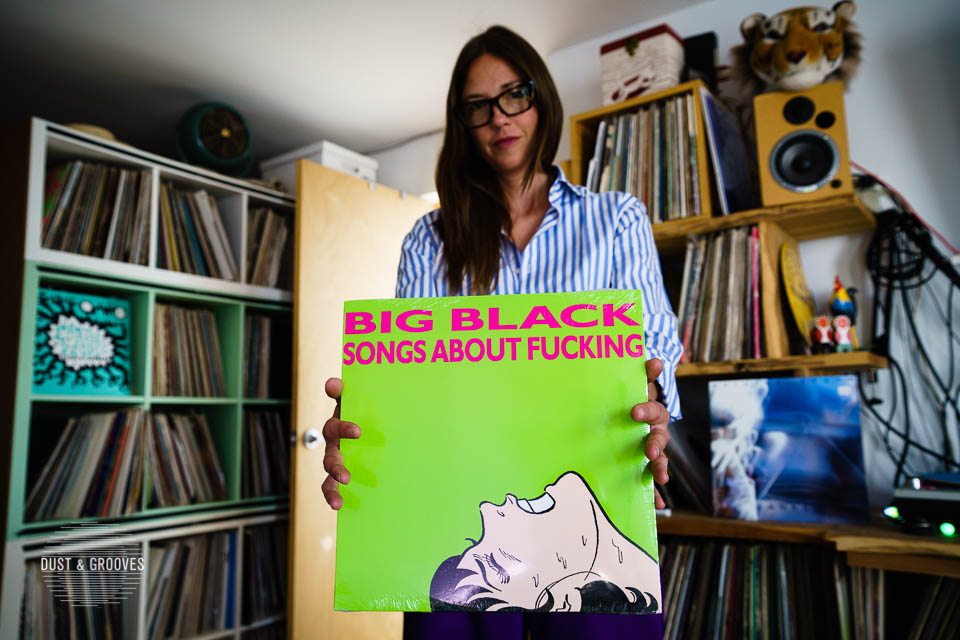 Big Black – Songs About Fucking. This record… I tried to sell it. I hate it, and that’s why I love it.
Big Black – Songs About Fucking. This record… I tried to sell it. I hate it, and that’s why I love it.
Did you have any friends you’d share your collecting journey with?
There were many friends that I shared musical journeys with, but we didn’t collect together. It‘s primarily something I do on my own. It’s a way to relax.
Did you have any mentors that showed you the ropes? Did you ever even feel like you needed to be shown the ropes?
My dad showed me the collector ropes.
Why did you decide you would more formally DJ and what drew you in?
There were three major moments. Heating drum ‘n’ bass DJ Josh Wink was the first in Texas. But, DnB would have required a lot more bedroom DJing than I ever did… years maybe, before you’re ready to play a set. I started playing in bars about four months after I decided I wanted to disc jock.
And that’s related to the second moment that drew me into playing. I saw these guys goofing around in the booth at a hip lower east side party playing Bowie, OMD… all the stuff I already had in my collection. Honestly, they were horrible, train wrecks, sudden volume changes, the works, but it was inspiring. Pat Field was there, it was fun. It was approachable. So after that I bought turntables, and started looking for gigs with a mixtape calling card (TAPE, mind you).
What sealed the deal and made this a life-long pursuit was when I heard DJ Eric Duncan playing DJ Harvey’s Sarcastic clothing mix commissioned by Paul T.
Paul ran these massive underground parties in LA with Harvey headlining, and the mix was part of all that cosmos. It is arguably THE mix that put Harvey on a world stage as (probably?) one of the top grossing DJs today. It was underground dance music then with Crimson and Fleetwood Mac worked in. After hearing it, myself and everyone back then asked… “Is this dance music?”
Every convention as I knew it disintegrated. A new world opened up and it sparked my desire to learn all I could about the art of developing live, rich tapestries of sound that affect the energy in a room and in a person, and it’s a study that gets richer with time.
When I started DJing the aims of collecting records changed.
I opened Lit as the Friday night resident upstairs. It was THE rock bar of the LES. Justine D was the Saturday night resident, and all the band kids would hang there, like Interpol, The Yeah Yeah Yeahs and LCD Soundsystem. It was a place where I could play all the music I’d collected in Austin before I knew I would DJ. I loved to play a 45 released by a local Austin band, The Cherubs covering Blondie’s “Dreamin’”, for example.
After about a year there, a man came around who was opening a bar called Uncle Ming’s on Ave B and offered twice what I was making at Lit and a Friday/Saturday night residency. I loved the Lit gig, but I was ready to be paid more. DJing and working at Stooz (record store) were my only gigs, so a pay increase like this was hugely motivating.
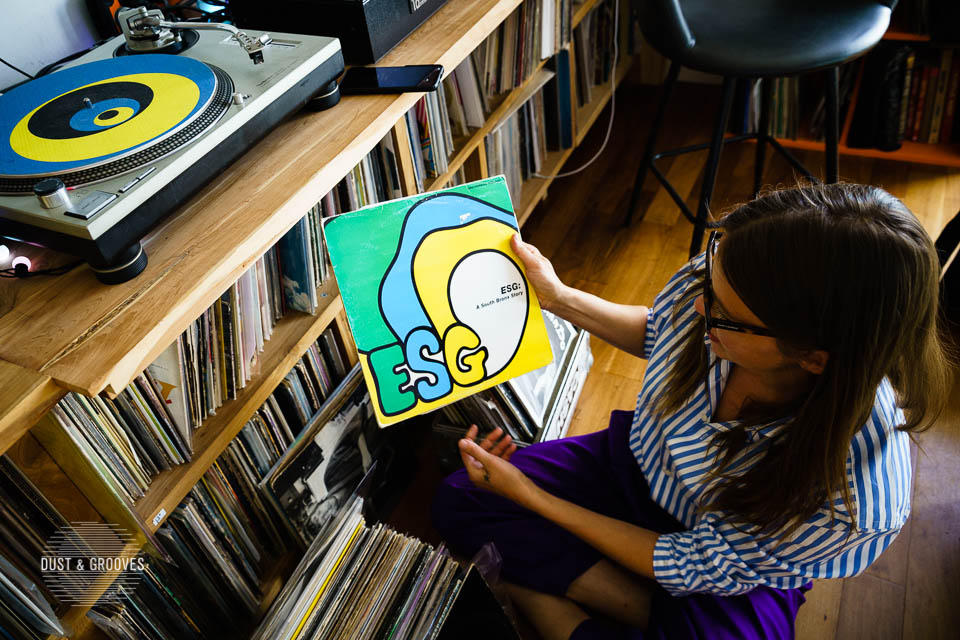 ESG – South Bronx Story. Every LES DJ in New York had this record in the naughty aughties. It was highly influential in garnering the nu disco sound born out of the time.
ESG – South Bronx Story. Every LES DJ in New York had this record in the naughty aughties. It was highly influential in garnering the nu disco sound born out of the time.
The owner Robert was cool, but for some reason his club attracted the infamously uncool, the bridge-and-tunnel crowd. They were not into my weird post punk music. They needed a constant beat and didn’t really like the jarring sonic surprises I was so fond of making. So I was forced to find solutions in crossover bands like ESG and Liquid Liquid, or songs like “Magnificent Dance” by the Clash. There’s also this great roller disco remix of De La Soul’s “Saturday”, I played every Saturday. That worked.
Then I met Eric and Thomas Bullock one night at The Hole. Knowing them super charged my learning. They took me deep into the world of disco as I had never understood it before, one that Harvey described as being “not for children.”
For example, a crew of us were hanging out, listening to records at Eric’s one night. This is what you did back then, BTW. It was THE best way to learn about records. And there was one record in his collection that caught my eye. I had the same record, and I played it almost every night. But the sound was radically different from what I thought Eric was into. I pulled it out of the stacks and said, “YOU have THIS record?” He said yeah, “It’s a secret weapon.” To which I said, “What’s a secret weapon?” So he put it on, and this is classic… he didn’t play the same song I played! It was Ministry’s I’m Falling EP and he played “Primental.”
“Primental” is a song that soars, but is grounded in a super striped and forward funk bassline, washed by repeating cascades and crescendoing synth melodies. I still love it and find it to be a song that nourishes me. But it was so different from what I thought of as dance music. It’s very slow, but it absolutely compels you to dance. I’d never thought of dancing like that before, and hearing it cracked open some neural DJ pathways in me.
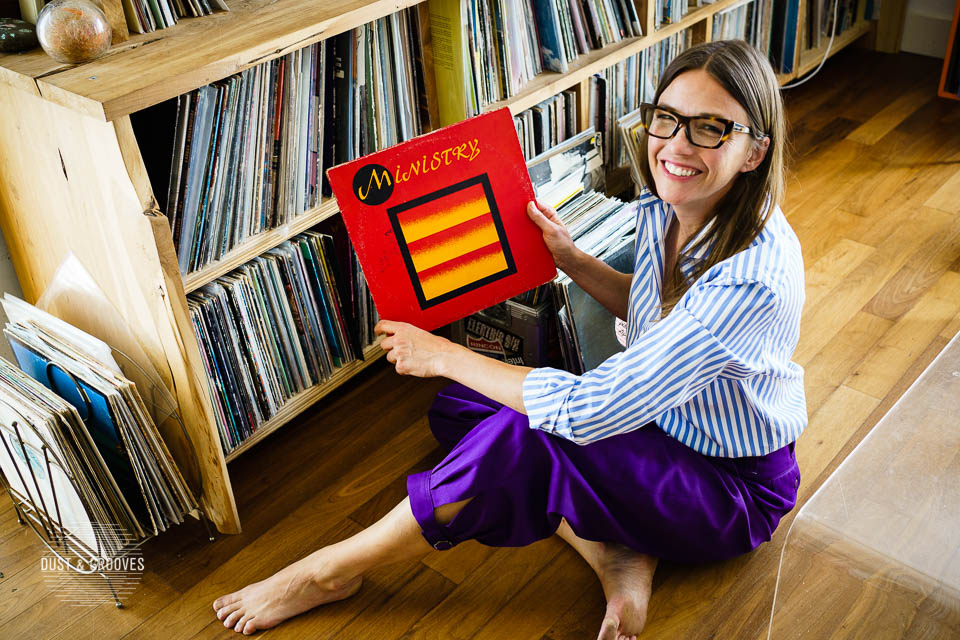 Ministry – I’m Falling. This was a record that I played in the punk clubs until an early DJ mentor showed me a deeper cut from it that I still love and play today.
Ministry – I’m Falling. This was a record that I played in the punk clubs until an early DJ mentor showed me a deeper cut from it that I still love and play today.
 Between MInistry’s New Romantic sound and the hard stuff was this release on Wax Trax! Records. You can tell how much the label owners believed in this record by how much care was put into the sleeve design.
Between MInistry’s New Romantic sound and the hard stuff was this release on Wax Trax! Records. You can tell how much the label owners believed in this record by how much care was put into the sleeve design.
Other DJs showing you the cuts is a big deal. Most of these songs and records were not rare, but the thinking behind them was rare. I’m pretty sure that Eric didn’t discover “Primental”. Maybe it was a song Andrew Weatherall played, and Harvey heard it at a UK party and then played it at APT. You acquire these vinyl gems through field research and personal encounters. You couldn’t access info like this on the web back then.
For example, one of my teachers, Phil Mison, is known for his work with Jose Padilla in Ibiza. They pioneered a new sound that was specific to the sunrises and to the Balearic Islands which continues to influence musical realms today.
After many years of spending time with Phil, arranging gigs for him in LA and NY, I felt I got to the bottom of what Balearic music really is about. I did this, first by listening to his music all that time. Still not satisfied, I pried further, and one day got him to tell me what the islands are like. He went deeeeeep into the history, starting in the 1950s. The conversation created a suspended state in me, in which I was able to put myself there feeling the gravity of the place. After that encounter, I felt I understood all that I needed or could know at that time.
This is how I was shown the ropes, through hearing the music and asking questions from the professors who had first hand experience. Phil Mison, Dewey Chan, Harvey, Tony Watson, David Mancuso, Rub n’ Tug, Hugh Herrera, Danny Wang and DJ Spun, these guys were all my teachers.
That’s a lot of great teachers! Yet they all kind of go back to the clubs, the Loft and New York nights for me. Do you recall any Mancuso stories that you care to share?
I have had so many great teachers in various worlds. I am deeply grateful for this.
Mancuso is more of a peripheral mentor. I learned a ton just going to the Loft. Paul T bought my ticket. He was the one who brought myself and a whole new generation of people to the Loft which continues today.
Before my first Loft, Harvey painted the picture of David as a man who’d dedicated his life to his musical family, who’s needles were made by a man in Japan who also made swords, and who never mixed records, leaving everyone to stop dancing and clap between songs. It was revolutionary. So different from the idea that a DJ must mix continually.
I was hooked after my first Loft, but we were outsiders, the new young kids until Mancuso played a song remixed by someone in our crew. It was Eric and Thomas’ “I’m a Man” remix. That’s when I knew that David had accepted us under his fostering care. This was 2003.
David and I lived in the neighborhood, and I would often run into him on the street. He would give me an acknowledging head nod, which was everything. I was so entranced with all that was cosmic… any encounter with David could send me over the moon. He was the godfather of dance music as I appreciated it. I felt like just being around him or seeing him on the street imbued me with sacred DJ knowledge.
He often visited a friend who lived above a restaurant I worked at called 9th St Market. He would pop his head in and say hi on his way up to hers. It was a small place, only one waiter per shift. I was blasting Tupac one day, setting up.
It was around 4 o’clock and the afternoon sunlight streamed in through the windows. David suddenly steps into the light and is silhouetted as he says, “What?! Hip-Hop?!” He didn’t play hip hop and didn’t understand how I could like it.
I had to pause before writing this next part because I started crying. I miss him, a lot.
Besides of course what he played, the way he played it, and his approach to sound… he taught me through his fragility. Seeing him back then, he wasn’t bouncing down streets open and smiling. He was hunched over, often looking like he hadn’t bathed, shaking and seeming like he could barely handle the energy of simply being outside. Despite that he had this heavenly knowing about him that in this Tupac case was literally backlit. He was a classic portrait of an artist. He gave his life to his art. I think it took a lot out of him, and I deeply admired his type of dedication.
 House Master General – The House Master. Early house 12”s with designs as minimal as their approach to music are something I love.
House Master General – The House Master. Early house 12”s with designs as minimal as their approach to music are something I love.
What is one record that would define your beginnings as a collector? Do you still have that record?
Probably my Michael Jackson ET record, because I had to earn it. I consider it a jewel of the collection.
But I think I’m only recently understanding that I am a collector. I used to think that “real” collectors would drop 100 bucks or more for a record online, and that buying records online was a form of cheating because it canceled the possibility of synchronistic moments with vinyl. So I didn’t want to be considered a collector. Working at Public Records and meeting a good amount of serious , super cool and inspiring collectors, I learned that my thinking was a pretty limited way of understanding the practice.
Now I recognize that I am a collector, in part because of the pandemic. I started getting into the discs with more time at home and started to realize what I’d done or what I’d been doing, digging and buying all my life.
Until now I’ve only thought of my collection as a tool for DJing. Now I want it to exist as a library. I want the records I’ve collected to inspire conversations about politics, art, sociology, ideology and all of the circumstantial factors that led to the creation of a specific piece of music.
In what other ways did you interact with music throughout your life?
In my Austin years I was also in a handful of short lived bands, I sang backup on a few records for others and I was the Entertainment Editor of my school paper. That work led to an invitation to lead a SXSW panel entitled, “Why the Music Industry Sucks” (1994). Around that time I got an entry level job at the Austin American Statesman and started to work for their entertainment section.
In New York, I was super focused on DJing within the disco and new disco sound, and in LA I was learning A LOT from the underground scene on house music history. Living on the two coasts afforded me the chance to see how these micro dance music cultures developed locally and pollinated sometimes globally. In LA, I also started training as an energy healer and studied sound healing with composer John Beaulieu.
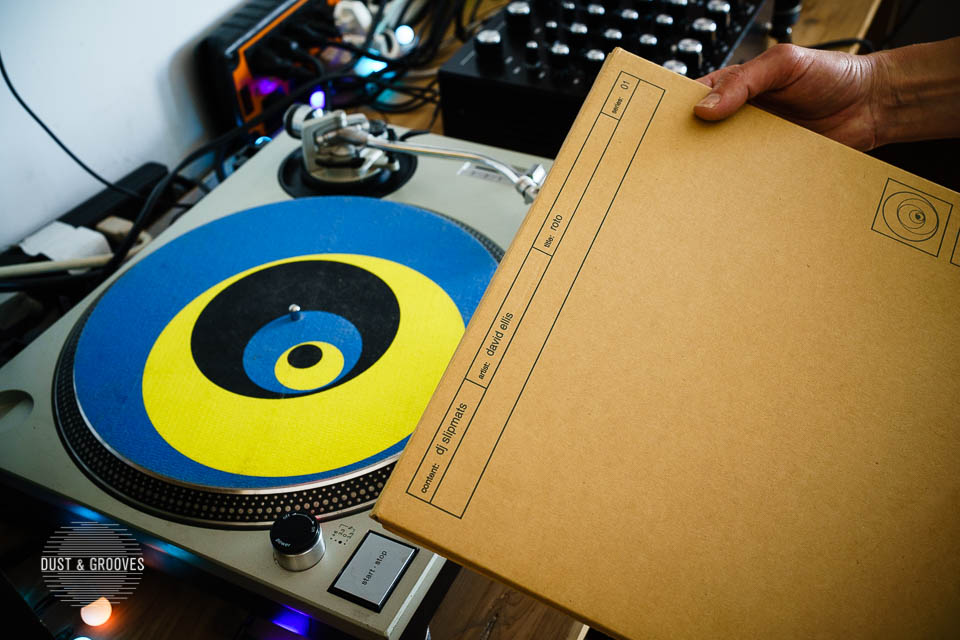 David Ellis – Roto Slipmat Edition 250. I went to a BBQ the artist David Ellis was hosting with my friend José Parlá back in 2005. He was very generous because we’d just met, but once he found out I was a DJ, he gave me these slipmats he’d designed.
David Ellis – Roto Slipmat Edition 250. I went to a BBQ the artist David Ellis was hosting with my friend José Parlá back in 2005. He was very generous because we’d just met, but once he found out I was a DJ, he gave me these slipmats he’d designed.
What brought you to LA? How did you get into energy healing? Did you move your records with you across the country?
NY and LA, the Ying and Yang of ‘Merica.
NY 2005 was the beginning of a major shift in the NY nightlife tapestry. My friend Agathe Snow and I were noticing that, and she suggested making a film about it, which we did. It was a 72 hour dance party we called Stamina. My future husband, artist Alex Czetwertynski, came from Paris to work on the project with us. The three of us worked… for 2.5 months and showed it that year in Art Basel and 10 years later at the Guggenheim NY. Agathe went on to have a great art world career. Cheryl Dunn, who was one of our cinema photographers, used a lot of the footage she shot at the party in her Dash Snow doc, I believe. It was a success.
At the end of filming and taking it to Miami, I was exhausted. I was already burning the candle at both ends, hustling an income on a local DJ wage, but I was seriously wiped after that. A few weeks after it all ended, Alex had a prophetic dream that I should go to LA. I thought it was a great counter to the post-project/deep winter blues I was experiencing, so I listened to the dream and treated myself to a trip.
I spent one night in LA and my friend Hugh asked if I wanted to go to Mexico with him. So I drove down to San Diego to get him and then we drove on to a place on the Sea of Cortez in Baja.
It was absolutely magical and healing. There was a new moon and so the tides of the sea would roll out very far, like a mile out at low tide and come all the way up to the house during low tide. The water was absolutely opalescent at times. The landscape was so stunning, the only other place on earth that has struck me in the same way was Iceland.
In the morning you could see schools of dolphins and fish and flocks of birds going south and in the afternoon they’d all come north. It was a calm meditative space, and one morning there I woke up with the revelation that I needed to move to Mexico and open a “disco retirement home” near an awesome surf spot.
It felt like it was time to leave NY. Stamina had been my swan song.
Alex later joined me and we traveled together through Central America and Mexico, finally coming back to the US via LA on a bus ticket we bought with borrowed money. We were going to work on the hotel from there.
I didn’t move my records to LA then. I put everything in NY storage before flying to Costa Rica with a backpack of possessions. I even left my cat with a friend. We were a young couple starting out and had NO money. Our groceries in our early LA life were bought exclusively at the 99 cent store and sometimes we had to choose between food or gas to get Alex to work.
So I started my LA record life with one bag (along with one turntable and my cat) after returning to NY for a project there. Of course then, I started shopping at the LA bazaars they have like the Rose Bowl and at Amoeba, an AMAZING place to find house and dance music in the 50 cent bins.
What I had in NY and what I was finding in LA for super cheap got a little fuzzy, so I ended up with a lot of doubles. My east and west coasts’ collections were all united when I moved back to NY in 2012. I didn’t know it then, but those dollar records would increase in value. Now I’m selling my doubles.
Energy healing work came via being a mom. A parent suggested I take Cassia to a Cranial Sacral practitioner for allergies. Whatever this doctor did, was highly effective, but he was VERY expensive. A friend of mine suggested I learn the work myself to save money.
I found a great teacher, Gary Strauss from Queens. He had a couple of things going for him, a beard (highly revered by my DJ mentors who called themselves “Beard Lords”), and second, he was from NY. I missed the city like crazy. Third, he had a lot of books about sound healing with tuning forks written by John Beaulieu. I ended up studying with both of them, and I really enjoy that work.
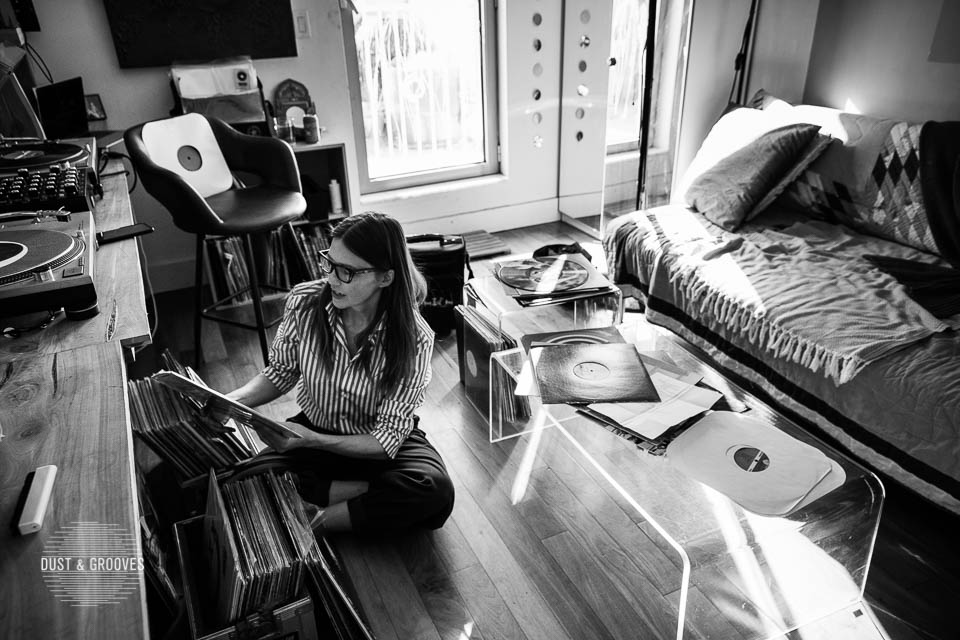
Relating to DJing… When was the first time you saw a DJ at a club? Were they playing records?
It was in the summer of ‘92. I was in NY as an IMG model new-face girl. I had just finished a photo shoot where they dolled me up like twiggy which was also very Deee-lite, befitting the club kid look at the time. My aunt, (the rockabilly punk rocker now Brooklynite), told me to meet her at the Limelight after the shoot. It was a Disco 2000 night.
The DJ was probably DJ Keoki or DB and it had to be all vinyl. The CD technology at the time wasn’t really functional. Anyway, I didn’t even look at the DJ booth. I hit the dance floor right away. I’d NEVER heard music like that before. I had never moved like that before. I immediately fell in love with the sustained energy mixing records seamlessly created and I danced forever.
Did it capture your interest from the start?
Yeah. Totally, but it was the whole experience. I was FOB. I had no idea how to get into a nightclub. I was about to ask the door person if they knew how I could find my aunt, when someone I’d met at the Pat Field store earlier recognized me, grabbed my arm and said, “She’s with me,” and yanked me in.
I was a deer in the strobe lights. I asked him if he could help me find my aunt. He laughed and said, “I got you in, Honey. You’ll have to do the rest on your own.”
Voila, there I was in this multi-level “magic theatre”, where the normal rules that bound people to a dense normalcy disintegrated at coat check. I didn’t know anything about club life, so I didn’t know that everyone was rolling on imported E or what have you. What I did know was that this was a place where personal freedom reigned. It was life changing. Women didn’t have tops on, and painted nipples as a form of dress. The bathrooms were all genders, not to mention the fabulous club kids’ looks.
I felt it was an “only in NY” thing and sadly I had to go back to Texas and finish high school.
In Austin, there was nothing like the Limelight. The closest you might get was at Oil Can Harrys, a gay club I used to go to with a friend. The boys all dressed in cutoffs and tank tops and the music was danceable. It was ok.
I couldn’t get into it. I was looking for the pomp, costume, music and energy I’d experienced in NY. Nothing I found came close. I poured myself into the live music world after that because I didn’t find my fit with the dance scene in Austin.
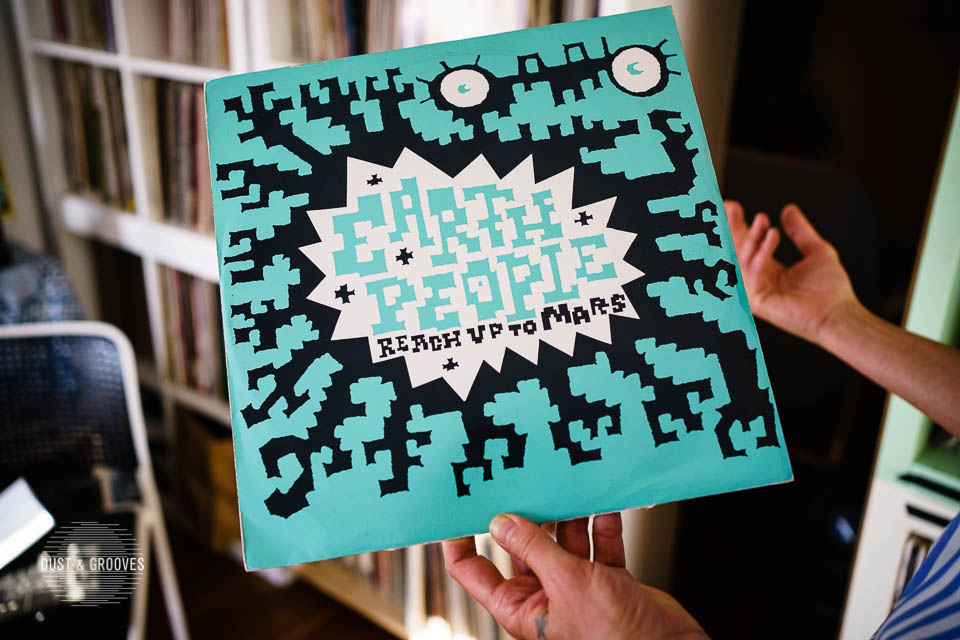 Earth People – Reach Up to Mars. DJ Jun Bug gave me this record in LA. Later in NY, a DJ friend said he’d had an epic DJ moment while on tour playing it, but lamented that he didn’t have the vinyl. Not long later, I found a copy on the street and gave it to him. Cosmic Earth People love.
Earth People – Reach Up to Mars. DJ Jun Bug gave me this record in LA. Later in NY, a DJ friend said he’d had an epic DJ moment while on tour playing it, but lamented that he didn’t have the vinyl. Not long later, I found a copy on the street and gave it to him. Cosmic Earth People love.
What inspired you to become a DJ and why was vinyl part of that path?
I was finally inspired to DJ when I saw Josh Wink play at a rave in Austin ‘99? At some point in the mid to late 90s, Austin raves started up. My younger brother was a raver and so was my then boyfriend. I was really snobby about the rave scene. Most punk kids were. I didn’t even think to give it a chance. Nothing could top my Limelight experience.
My brother and boyfriend were out to convince me otherwise, and so I agreed to go to my first rave. We caught the end of Josh Wink’s set. He had, as we say in Texas, a “shit eatin’ grin” that fascinated me. I was convinced he had discovered the key to happiness. I wanted that. (Roni Size, Rabbit in the Moon, and Kool Keith also played that night).
The next day I went to the one store in Austin where I knew they sold Drum & Bass, “Turntable”, and I bought Roni Size’s 26 Bass/Snapshot 12”.
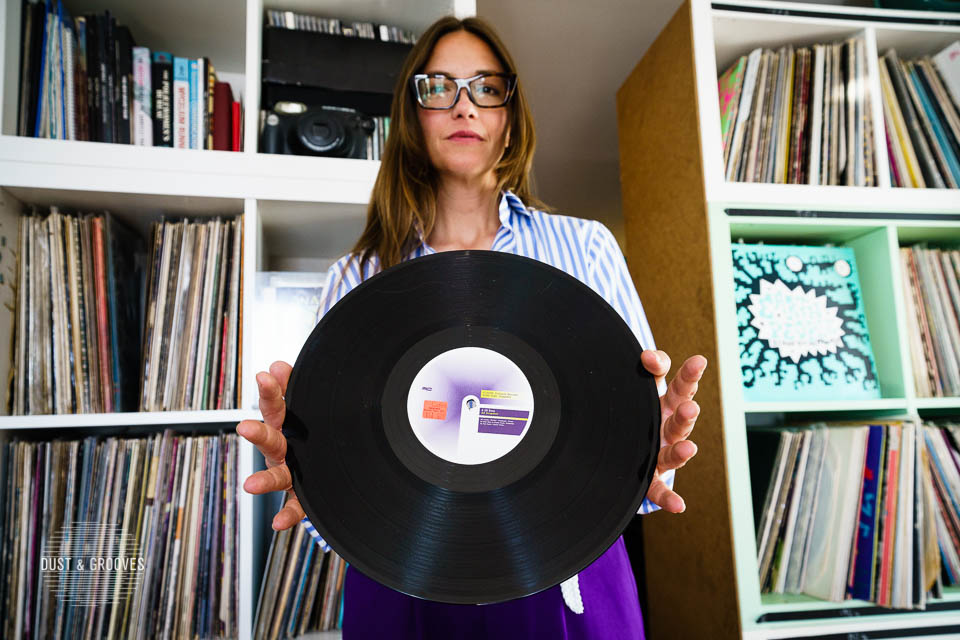 Roni Size – 26 Bass/Snapshot. I bought this record the day after going to my first rave from a store called Turntable in Austin. It is the beginning of my DJ career.
Roni Size – 26 Bass/Snapshot. I bought this record the day after going to my first rave from a store called Turntable in Austin. It is the beginning of my DJ career.
What shops would you go to at the time? Did you have a favorite?
I went to Waterloo, Tower and this little one behind Tower, but my favorite was Sound Exchange. Daniel Johnston painted his “Hi How Are You?” alien frog on the side. It was gritty. They sold ‘zines. It was a cultural hub. All the kids from the scene shopped and worked there. My favorite clerk was Lauren. I thought she was the coolest. Still do.
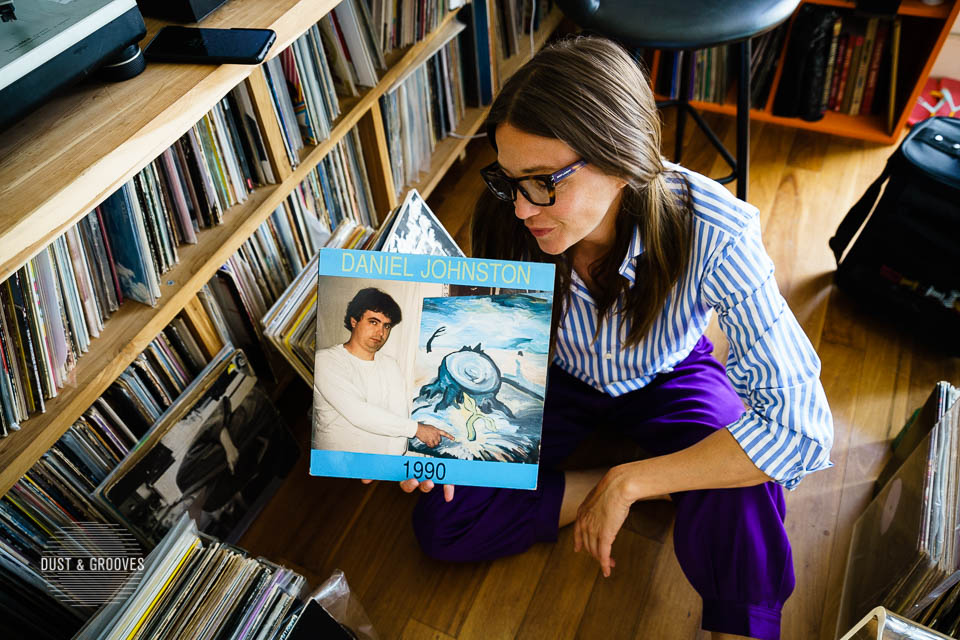 Daniel Johnston – 1990. Daniel Johnston is an Austin icon who inspires my compassion for humanity. Favorite songs: “Tears Stupid Tears” and “Don’t Play Cards with Satan.”
Daniel Johnston – 1990. Daniel Johnston is an Austin icon who inspires my compassion for humanity. Favorite songs: “Tears Stupid Tears” and “Don’t Play Cards with Satan.” 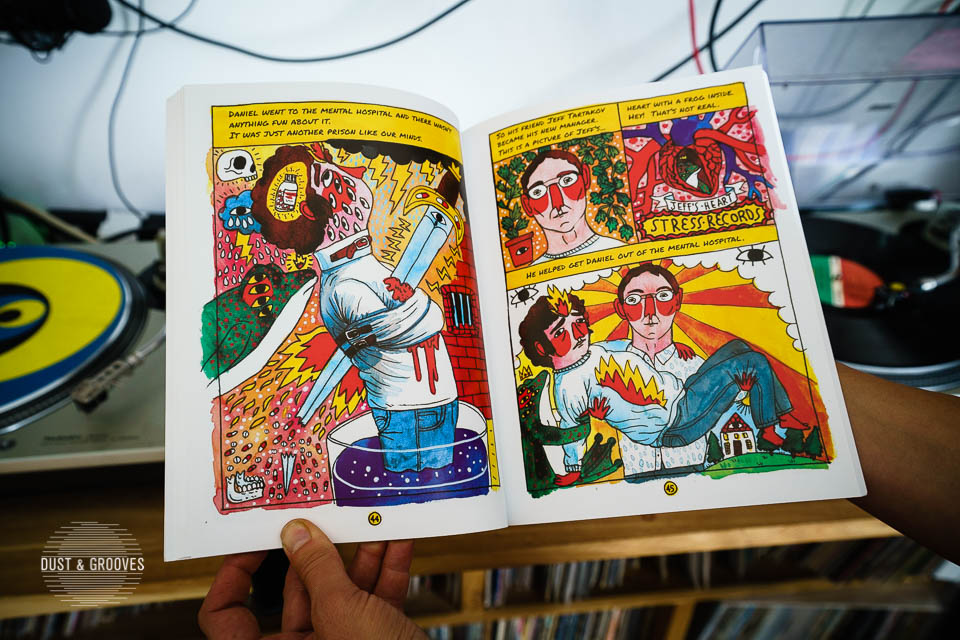 Scott McClanahan (author) & Ricardo Cavolo (illustrator) – The Incantations of Daniel Johnston. The Daniel Johnson story, one involving mental illness and radical devotion to religion is beautifully illustrated here. When I saw him perform, he seemed to be in so much pain, I can still feel the pangs of voyeuristic guilt.
Scott McClanahan (author) & Ricardo Cavolo (illustrator) – The Incantations of Daniel Johnston. The Daniel Johnson story, one involving mental illness and radical devotion to religion is beautifully illustrated here. When I saw him perform, he seemed to be in so much pain, I can still feel the pangs of voyeuristic guilt.
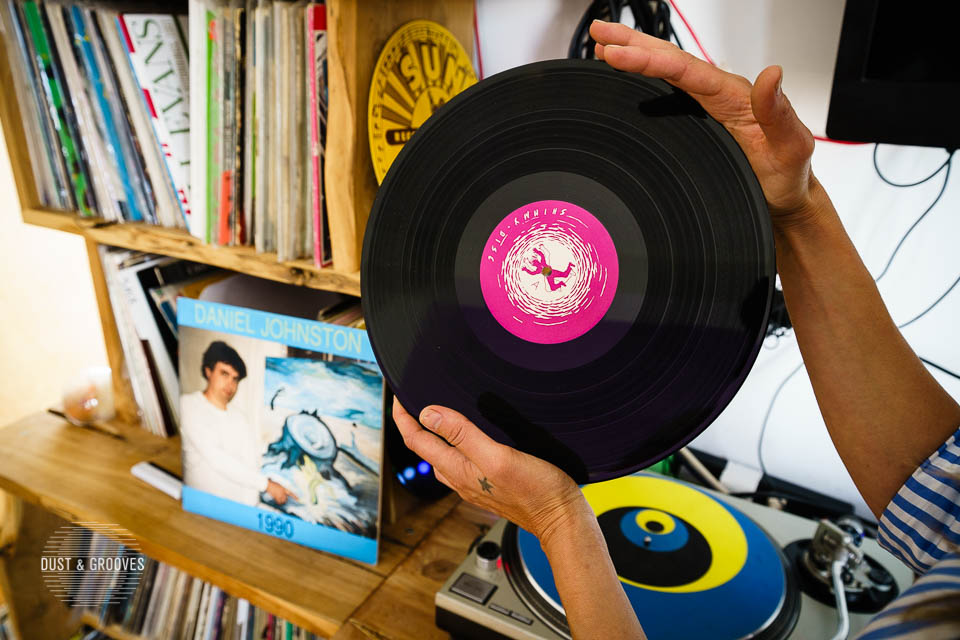 Daniel Johnston – 1990. I have a thing for the label Shimmy Disc’s art. I bought this Daniel Johnston record in the 1990s, and it’s now one of the more rare records in my collection.
Daniel Johnston – 1990. I have a thing for the label Shimmy Disc’s art. I bought this Daniel Johnston record in the 1990s, and it’s now one of the more rare records in my collection.
Did you ever have any record shop rituals? Was there a bin that you gravitated towards first?
My technique was to know the inventory so I could hone in on the new arrival bins.
When I started DJing my ritual changed a little bit. I became even more instinctual. I read tarot cards and I find that it’s the same when flipping through crates. You find the records you’re somehow energetically attracted to. If you and a record connect, there’s a cosmic reason.
I found MURK’s Some Luvin’ this way at Amoeba. The first time I heard it, I cried and played it over and over again. Dewey (who’s been playing since the 80s) heard me play it at a house party, and told me the back story about MURK, about the song’s impact socially, about the Miami house scene. I told Dewey I found it in the 50 cent bin at Amoeba and he said, “No. That record found you.” You could almost call these moments fate.
Did you hone in on a particular genre at certain periods of your life or were you into everything?
Oh… everything. Absolutely everything. It’s all connected. The older I get the more broad “everything” becomes.
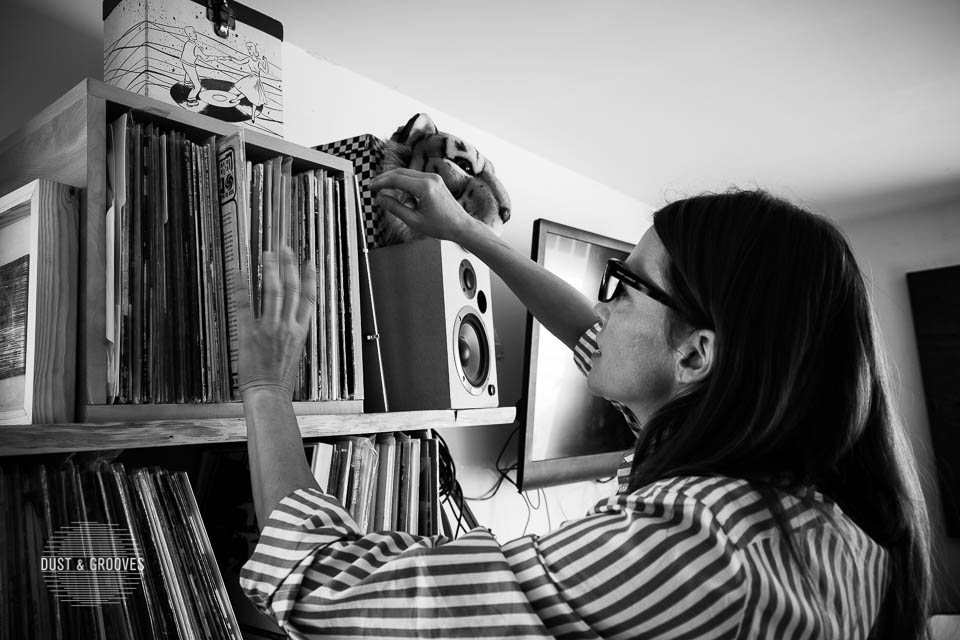
Tell me about your record shop clerk days…
My record shop days were less about the music I could find there and more about the community. I worked at Stooz Records on 7th St between A & 1st Avenue, Turntable Lab was next door. I had friends who worked at A-1 which is still on 6th between A & 1st. Club kids Heatherette had a studio across the street from Stooz which was next to The Strokes’ management office which they were often hanging out in front of, and then down the street you had Ryan McGinley’s infamous apartment. He, Dash Snow and Dan Colen were usually sitting on the stoop steps in front hanging. It was a scene. I started working there in 2002.
Before I worked at Stooz I lived in Ft Greene and would go to Beat Street in Fulton mall. I loved going there. They employed a reggae selector to spin records and sell them over the mic. Ft. Greene also had the best sidewalk sales with great records. Just walking around in the neighborhood you’d hear people bumping stuff out of their car, making a spring day sunnier. Inspiration everywhere.
Did your experience at Stooz change your perspective on any particular sound? Did it turn you on to anything you weren’t into before?
Stooz didn’t really, but befriending the guys next door at Turntable Lab and around the corner at A-1 certainly did.
How did the records in your shelves change through the years?
In the beginning I was collecting punk, post punk, new wave, hip-hop (a little bit), and jazz. Once I started DJing, Disco and left field dance was a focus, then house music and now, it’s a little of all of that plus what I consider to be the classic rock albums of the 60s and 70s.
Now I’ll allow myself to buy something that may be hard to randomly find in a store. I would really like to own “Screamadelica” by Primal Scream, for example. That’s something I would order because it satisfies my work toward a cohesive collection… a collection that is very personal, but that anyone who loves music could also appreciate.
 Les McCann – Layers. An important album because it’s almost entirely electronic, a first in the genre, and Slick Rick and Massive Attack sampled it.
Les McCann – Layers. An important album because it’s almost entirely electronic, a first in the genre, and Slick Rick and Massive Attack sampled it.
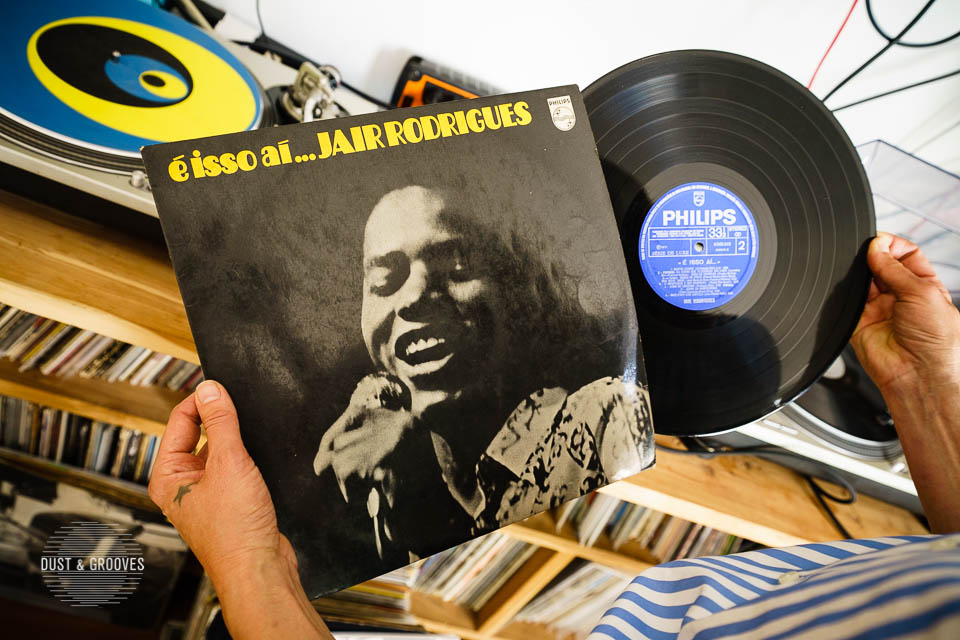 Jair Rodrigues – e isso ai… Jair Rodrigues. This came in hand-me-downs from my husband’s family who used to live in Brazil. It has this wonderful fullness of production, and I love his crooning!
Jair Rodrigues – e isso ai… Jair Rodrigues. This came in hand-me-downs from my husband’s family who used to live in Brazil. It has this wonderful fullness of production, and I love his crooning!
Did you find yourself revisiting any genres or sounds from your past at a specific point in your life? At several points in your life?
I’m revisiting my punk, post-punk, basically all the records I collected in high school.
That’s the fantastic thing about getting older. You can revisit things you loved once with a new perspective. When I was listening to this stuff the first time around there was so much I didn’t know about world politics about music history. Now I want to make a connection between Thatcherism and the Cocteau Twins, Reaganism and Black Flag, to talk about the importance of the Minutemen or why Sonic Youth was so impactful. The lens of time just gets wider with more of it.
If you could pick a record from your shelf that paints the landscape of your life in 2021, being who you are today, do you know what that would be?
I think it would be “Alien” by Larry Heard.
I thought of some records from my youth that really spoke to me and they were all vocal driven. At this point in my life, I’m not connecting to lyrics like I used to. Sounds paint more than words. Sounds are like remnants of memories that have been washed, eroded with time into suggestions of feeling. I’ve always been about space which I think is really about being elsewhere. Connecting to a terrestrial existence is something that’s eluded me, like I’ve been living out-of-body. This album, and I love the reissue for the added tracks, takes me through everything I can say “I know,” in its openness and specific synth sound and the occasional dance beat, and that’s too reductive to do it justice. It’s a masterpiece.
Was there ever a specific era, sub-genre, type of record or artwork that you became obsessed with?
Right now, I’m obsessed with a sort of thesis I’m exploring which is how Phil Spector’s Wall of Sound led to Shoegaze and then looking at all the ways that developed and branched off and perhaps led to genres like Vaporwave. That’s a fun one for record collecting in part because you have to explore Spector and the Beach Boys in mono and the exploration spans from the 60s through the 90s and on.
Did you ever pursue a particular kind of sound or are you more of a broad/wide scope collector?
I’ve been a broad scope collector, but one sound I would like to collect is the Lowrider oldies of LA. That music really resonates with me. Once Hugh took me on a mission to a store called Norwalk Records way out somewhere in LA and it was almost all 45s. We had to drive over some sort of cliff where the landscape became more like the Mojave than Hollywood. It was magical. That place was the real deal. Their selection in the genre was crazy.
How did DJing influence your at home listening?
Before the Lot, when I was playing in very specific places, like clubs or lounges, I had to listen to music I’d play at a gig at home. So full length listening didn’t really happen, and when I couldn’t change the record every song, I’d listen to other people’s mixes/research.
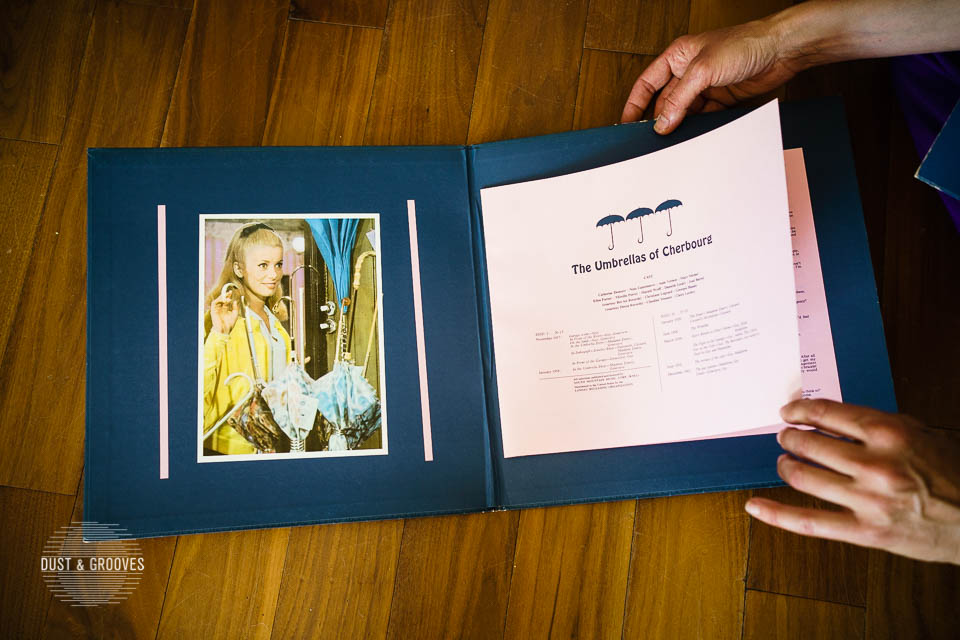 Michel Legrand – The Umbrellas of Cherbourg Soundtrack. This is not a rare record, but I love it for its story book presentation and for the radical concept of the film. It’s a musical, but the entire film is in song. It’s the only musical to date to ever try and do something that absurd with the possible exception of Hamilton.
Michel Legrand – The Umbrellas of Cherbourg Soundtrack. This is not a rare record, but I love it for its story book presentation and for the radical concept of the film. It’s a musical, but the entire film is in song. It’s the only musical to date to ever try and do something that absurd with the possible exception of Hamilton.
And during the lockdown, did you get reacquainted with albums? Did you develop new rituals?
Yes. Since I started DJing 20 years ago, it’s been rare that I listened to whole albums. Being Head booker at PR got me back into it a little bit as being around label owners like the Music from Memory people and being a part of a venue that has a record store in it, all lead to “longer listening.”
During the lockdown, I think we all went through a deep cleaning or rediscovery of self and stuff phase. And yes during that time, I turned to my collection, and said, “what’s in here? Let’s give you some love.”
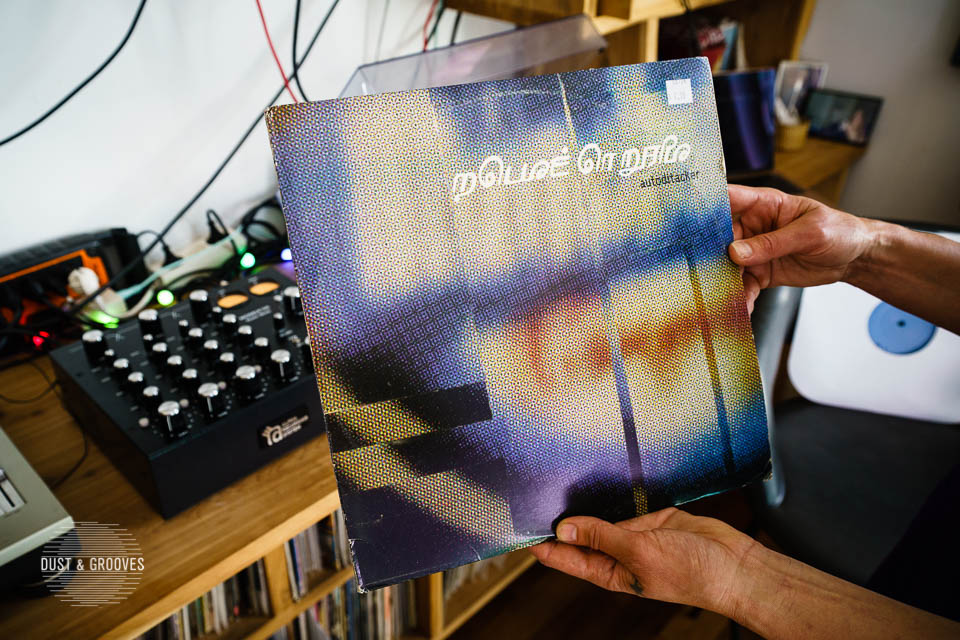 Mouse on Mars – Audioditacker. I rediscovered this in my collection recently. I’m getting into this wave-glitch, pop-IDM from the late 90s and it’s a great example of that.
Mouse on Mars – Audioditacker. I rediscovered this in my collection recently. I’m getting into this wave-glitch, pop-IDM from the late 90s and it’s a great example of that.
Did Disco Chicken also live at home with you guys? Can you explain Disco Chicken for us?
I’m not sure where Disco Chicken resides, but I can say I met DC when I was in Guatemala. I was shopping in the market, and I started hearing this amazing techno music from deep within the maze of vendors with a squawking chicken sample as a very present element of the song. I found the booth, and the guy knew what I was there for. He handed me a CD entitled, “El Pollo. El Lord.” And that’s when we first met, in 2006.
DC went on to walk in the Deitch Art Parade in 2007, and was a staple at the Hollywood parties, the warehouse parties, the afterparties. That chicken was a wild, party foul.
I kind of lost touch with DC when I moved back to NY in 2012. Then Lloyd asked me to play on the Lot (for the first time in April 2016), and he suggested I invite DC. They showed up, and the rest is Lot history.
Things really came full circle when two of the chatroom regulars showed up to a gig I had at Elsewhere, got on stage with me and danced. It was an homage of the highest feather (so to speak).
I think DC felt free after that to let go of the spotlight a little, and has since taken to smaller performance opportunities like bombing my husband’s corporate zoom calls. Naughty chicken. You can take the chicken out of the cage, but you can’t take the… something like that.
You’ve been a resident at The Lot Radio for how many years now?
Five. First I presented a weekly show, then I went to twice a month. Now I’m at once a month. I’ve put out around 250 hours of music via The Lot at this point.
How do you choose themes for the shows?
A photography teacher of mine used to open a dictionary at the start of the week, flip to a word and assign us something like “corner” to photograph by Friday. I loved how abstracted something simple like considering a corner could become.
So with that open spirit of interpretive possibility, I’ll choose from a variety of places. I sometimes use divination cards which resulted in the “Infinite Mirror” and “Swan” shows. Or there’s something I want to explore like the music of Richard H. Kirk or investigate why Chuck Berry was so important. I just try to notice what it is that is exciting to me when selecting for the show and stay true to that.
Sometimes, I just need to rock out and I don’t choose a theme. It’s all part of what makes the shows.
 The Orb – U.F.Orb. The “Towers of Dub”!!!! This was a record I ordered on Discogs, which means I was obsessed with it—in this case, the song “Towers of Dub”. It cracks me up every time I hear it, and I LOVE The Orb sound all around.
The Orb – U.F.Orb. The “Towers of Dub”!!!! This was a record I ordered on Discogs, which means I was obsessed with it—in this case, the song “Towers of Dub”. It cracks me up every time I hear it, and I LOVE The Orb sound all around.
What are some of your favorite themes you’ve explored and do you recall any favorite memories/records from that show?
My favorite show was the one I did with my husband on the roof of our building. The theme was Indoor and Outdoor and we timed it to air on what was slated to be the end of the Covid-19 lockdown in NYC.
Alex is a digital, new media artist. He mapped the skyline and spent weeks making CGI: 3D dancing characters, plants and trees that grew over the roofs, spinning shells with human legs, at one point François and Lloyd float by in the Lot container traveling like a blip. He made the imagery and then VJed live over the sky while I DJed.
The set explores themes related to isolation, dream life, release, and the changes to the city that our quarantined bodies might have imagined. I opened with Brahms: Violin Concerto in D Major, Op. 77, Bird’s Eye View by Uman, and a rare Kraftwerk recording with Florian Schneider playing flute (he had just passed).
Midway through the show is marked by a break to cheer for the health care workers. For that I pulled audio from youtube news clips of other days where people in NY were cheering. So I had that coming out of the speakers and happening live which I caught a little bit of on a mic’d line. Then it was on to the release part of the show: dance party time.
I read an interview in which you state that you ‘dress up for every gig’ – which is always a breath of fresh air seeing how the world of DJing can be quite boxed in. Do you have a collectors approach to your wardrobe also? How do the two intertwine?
Yeah it’s funny, I wouldn’t say that now because it hits me as a little contrived. But yes, often with the show themes “dressing up” was called for. The Dolphin show outfit was one of my favorites.
But when it comes to dressing, everyday has a theme. Maybe I’m like a chameleon and I pick up on fluorescent orange vibes in the air and have to reflect that through my threads. I’m attracted to color, odd shapes, utility, playfulness and craftsmanship.
But I do amp up what I might normally wear when I perform, because I can, and I’m colorful! I grew up in the Molly Ringwald/Princess Diana era dressing Barbies in Bob Mackie and Oscar de la Renta. I like shoulder pads, and I have since the 80s. There. I said it.
During your time at Public Records as curator, you oversaw bookings for the ‘listening’ room. Can you explain a bit about your role there?
The shared vision for the club was to create a community space that connected people of all generations, colors and orientations through music, dance and activism. This would be accomplished through a range of programming including live experimental music, jazz performance art, and lecture series. It was supposed to hit all the intersections of an intelligent music community, and be a place with a low environmental impact.
I was hired as Head Booker a month before we were slated to open. There were very few of us actually working on getting the club open, and we all did what we had to to get it off the ground and running. Eventually, I settled into the title Curator at Large, and I had my hands in a little bit of all the operations.
What was the intention, musically speaking, for that space?
The intention was to honor the past and encourage those coming up in the dance, experimental music and sound worlds. Two of the three partners at PR have degrees in philosophy and we shared what I saw as an academic approach to booking. Artistic integrity and sound were first. This was supported by an allegiance to the creators, professionally and personally. Many of the people who play at PR have causes they champion, which PR also wanted to support by lending the space for town halls, etc.
Regarding motherhood… When you became a mom, did you reach for other kinds of music? Did you think “I’d love to show this music to my kids?”
I did not reach for other music. I wanted to share what I loved with my kids and that’s what I played for others at my gigs.
I actually would run experiments when prepping for gigs with Cassia, my oldest child. If they started bouncing to it, adults would too. I began a playlist of every song Cassia ever showed interest in, because children are just no holds barred. They’re a great dance floor litmus test.
It was lovely to see how Cassia would physically interpret the music I played. They LOVED Rotation by Herb Albert, and would spin for the entire 8 mins of the song (at 2 years old). They’d implore me to spin and spin with them, not noticing I was turning green. Cassia would push me to my limits, threatening to throw a fit if I stopped. At a certain point I learned to let things go in that space and just spin. I swear they were a whirling dervish in a past life.
I’ve always hoped my kids would develop a relationship with music, whatever that may be. Of course we play music in the house all the time, but I never modified what was played for them. My dad always said it was a mistake to change your music for children, that they would learn to love what they were shown.
Do you have a special record that resonates with you as a mother?
The first Crosby Stills and Nash record.
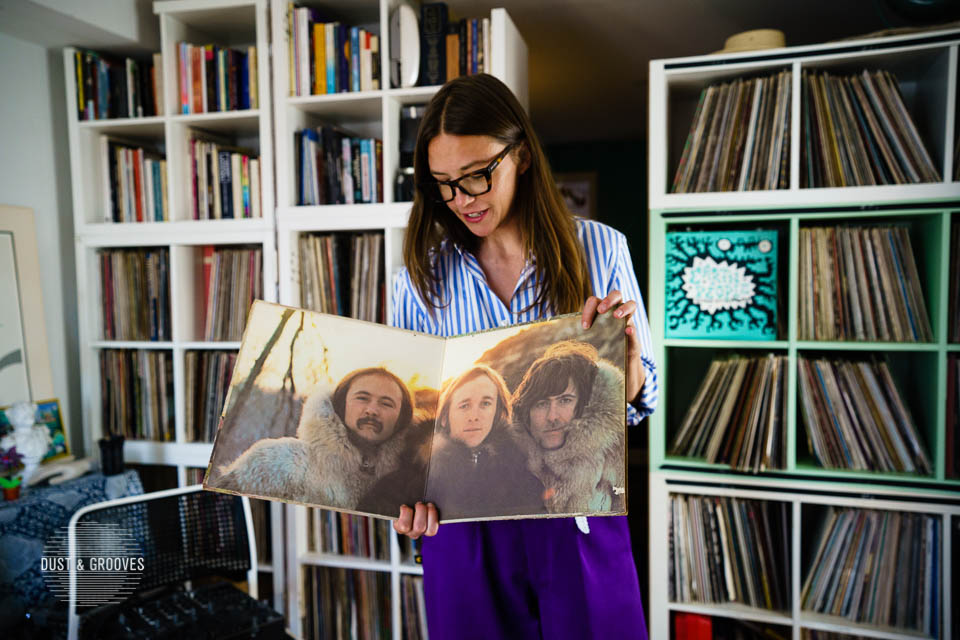 Crosby, Stills & Nash – Self-titled. One of my favorite records for “woodsie” food gatherings in the summer.
Crosby, Stills & Nash – Self-titled. One of my favorite records for “woodsie” food gatherings in the summer.
 Crosby, Stills & Nash – Self-titled. I used to live in Laurel Canyon where these guys reigned supreme on motorcycles and front porches. It’s a strangely beautiful place and this record takes me right back there. I recommend reading Laurel Canyon: The Inside Story of Rock-and-Roll’s Legendary Neighborhood, if you’re curious.
Crosby, Stills & Nash – Self-titled. I used to live in Laurel Canyon where these guys reigned supreme on motorcycles and front porches. It’s a strangely beautiful place and this record takes me right back there. I recommend reading Laurel Canyon: The Inside Story of Rock-and-Roll’s Legendary Neighborhood, if you’re curious.
What about it?
It’s almost too personal to talk about. But I had a hard time at the end of my first pregnancy. I was pretty upset one day, and I put that record on. It felt like angels came down and sat with me. I felt a tremendous amount of love and support. It quelled my fears. After that I thought about naming the child “Guinnevere”.
Assuming they did, how did your collecting habits change when you became a mom?
They became more digital because I couldn’t get to the stores as often, which I was really sad about. But you find your way. You can sometimes get someone to babysit while you shop or you can try to train your kid to dig with you. I would do this by allowing Cassia or Rose to pick one record every time we would shop. The rules were they could pick anything under ten dollars and they have to pick the one that attracts them the most. But you know, they can’t look as long as I can. And you have to keep an eye on your kid in the store. Sometimes I could time shopping with naps in the stroller and I always thought that must have looked funny. I’ve never seen another mother pushing a stroller with a stack of records in the bottom bin.
How about when your children became more independent?
That’s just happening now, and I’m trying to get back in the habit of going to a store once a week as I have a little bit more time these days.
Do you try to pass on your love for music to them?
I think I do but it’s an effortless outcome of sharing our home. I believe the best way to pass stuff on is to play what you want to hear. They’ll decide if they like it or not. Cassia likes almost everything Alex and I play and they’re starting to discover their own music. I encourage them to share that with me and then I connect the dots, with convos like, well if you like that you might like this and so on.
We also play a game when in the car. Everyone gets to share one song in succession. That always leads to a musical education, on both sides. Cassia has been teaching me about a lot of stuff lately, like Lo Fi music.
Do they have any favorites?
We have family favorites like “Road to Nowhere” Talking Heads, “Finally” by CeCe Peniston, “Take me Back to Piaui” by Juca Chavez, “Discipline” Throbbing Gristle and “The Immigrant Song” Led Zeppelin. “Anarchy in the UK” is becoming one as well.
 Led Zeppelin – Led Zeppelin I. A favorite record. One lived in NY and the other in LA… time to deflate. Of course I’ll keep the picture disc and a black vinyl pressing: one for sound and one for kicks.
Led Zeppelin – Led Zeppelin I. A favorite record. One lived in NY and the other in LA… time to deflate. Of course I’ll keep the picture disc and a black vinyl pressing: one for sound and one for kicks.
If you could pick one record that would represent each of them, what would those be?
Herb Alpert’s Rotation for Cassia. For Rose, I think of the song Blackbird by The Beatles because she likes to play that on piano and sing with me. I also think of the Dagar brothers because as soon as I went into labor with her it was the only type of music I could tolerate. Everything else we’d planned to play sounded like abrasive noise.
With your upcoming move, I know you started pruning your collection. What is coming up for you as you do this? How do you dictate what goes versus what stays?
I’m recognizing how much work I’ve done as I prune, and that I am a natural musicologist of sorts. That I have a story I’ve assembled through the records and I want to share it and inspire other people’s stories.
Editing it down was a little touch and go until I established a process for doing it.
Everyone’s biggest lament in this world are the ones that got away. It’s very sentimental, the act of collecting. The records we collect mean something to us, every single one, but I think being fluid with them is key. Your collection should work for you.
Using the Marie Kondo approach, I ask, “Does this record bring me happiness?” and sometimes I have to play it to know. Then I allow myself to love the record for any reason, the memory of when I collected it, for its sound quality, for its place in music and world history and so on. Sometimes I’ll look up reviews to go deeper into its history.
Another question I ask is whether lugging this thing around is worth it? And then I try and see where it fits in the collection. I have three Candi Staton records. Do I really need all of them? Which are my favorites?
One thing I struggled with for a while is the question of who am I making this collection for? I have finally come to terms with the fact that making it for myself is a good enough reason to do it. But what happens when I die? What happens when our friends die? What happens to their life’s work? Their record collection? Isn’t that worth something to someone else?
Who would you like to see next on Dust & Grooves?
Lauren Rob. Record store clerk from the early 90s Austin punk scene.
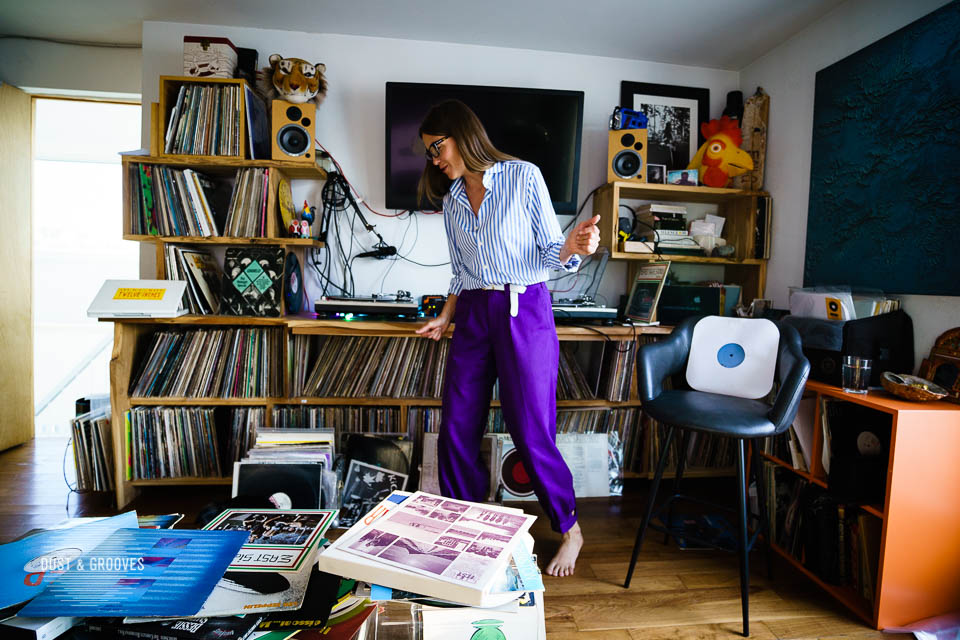
More about Christine:

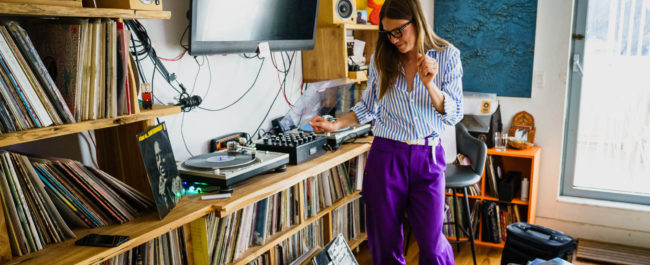

Great feature, thanks to all involved!